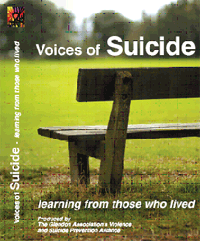
Measure a broad range of self-destructive behavior patterns with the FAST and screen for suicide intent with the FASI.
New documentaries address suicide from the perspective of three individuals who attempted it. See below for details.
Purpose:
Measure self-destructive behavior patterns and screen for suicide intent in ages 16-70 years
Age Range:
Adolescent
Adult
Elder Adult
Admin:
Individual or group
Time:
15-20 minutes for the FAST; 5 minutes for the FASI
Qualification:
B
Sample Reports:
N/A
Related Products:
Eating Disorder Inventory™-3
Reynolds Depression Screening Inventory™
Hamilton Depression Inventory
Reynolds Adolescent Depression Scale, 2nd Ed.
Trauma Symptom Inventory™
Suicidal Ideation Questionnaire
Firestone Assessment of Violent Thoughts™
The FAST is an 84-item self-report measure that is derived from 20 years of clinical research into self-attacking attitudes, or introjects, that restrict or impair an individual’s psychological development.
The FAST was designed to capture different symptoms that are characteristic of suicidal individuals including hopelessness, depression, anxiety, and suicide ideation. In addition to providing a means of assessing these characteristics, the FAST is a measure of a broad range of self-destructive behavior patterns.
With the FAST, the clinician can identify the level at which the client is experiencing the highest frequency (intensity) of self-destructive thoughts. Utilizing this information, clinicians can direct their interventions toward the area(s) in which clients are experiencing psychological pain, thereby potentially averting the acting out of the corresponding self-destructive behavior. This aspect of the scale is particularly important in the case of suicide, for which immediate, appropriate intervention may be lifesaving. Clinicians also are able to identify and address less extreme types of self-destructive thoughts before they lead to or precipitate a suicidal crisis.
The FAST is organized into 11 levels of self-destructive thoughts (i.e., from Level 1-Self-depreciating thoughts of everyday life to Level 11-Injunctions to carry out suicide plans).
The FASI is a brief suicide screener that clinicians can administer when they wish to assess only suicide intent. This subset of the FAST consists of 27 items from Levels 7-11 of the FAST. These 27 items, which compose the Suicide Intent Composite of the FAST, are the most predictive of suicide risk.
Special Features
Reliability and Validity
FAST/FASI Materials
The FAST and FASI materials consist of the Professional Manual, the FAST Rating Form, the FAST Scoring Summary/Profile Form, and the FASI Rating Form/Scoring Summary/Profile Form.

Voices of Suicide: Learning From Those Who Lived
This compelling documentary for mental health professionals explores what was happening in the minds of three people who narrowly survived suicide attempts. Their unusually articulate personal accounts reveal the contents of an insidious thought process or “inner voice” that urged them toward the ultimate act of self-destruction.
Their accounts, in conjunction with interviews from world-renowned experts in the field, including Drs. Alan Schore, Israel Orbach, David Jobes, David Rudd, Robert Firestone and Lisa Firestone, provide clinicians with insight into the relationship between early developmental experiences and later suicidal behavior.
Particular attention is paid to the significant role of disassociation, which may originally serve as a survival mechanism, but in later life facilitates the “acquired ability” for an individual to attempt suicide. 61 minutes

Understanding and Preventing Suicide
“My real purpose for wanting to make this film about suicide for the public is to educate all people about what to look for in their friends, their family members, their loved ones, their coworkers, their fellow students that could alert them to the fact that this person is in trouble, that they need help.”
– Dr. Lisa Firestone, Director of Research and Education at The Glendon Association
This powerful new film for the general public highlights the lives of three individuals, Kevin, Susan, and Trish, who made serious suicide attempts and lived. Listen to their remarkable stories and journeys to recovery. Learn from experts in suicide prevention and treatment.
30 minutes


